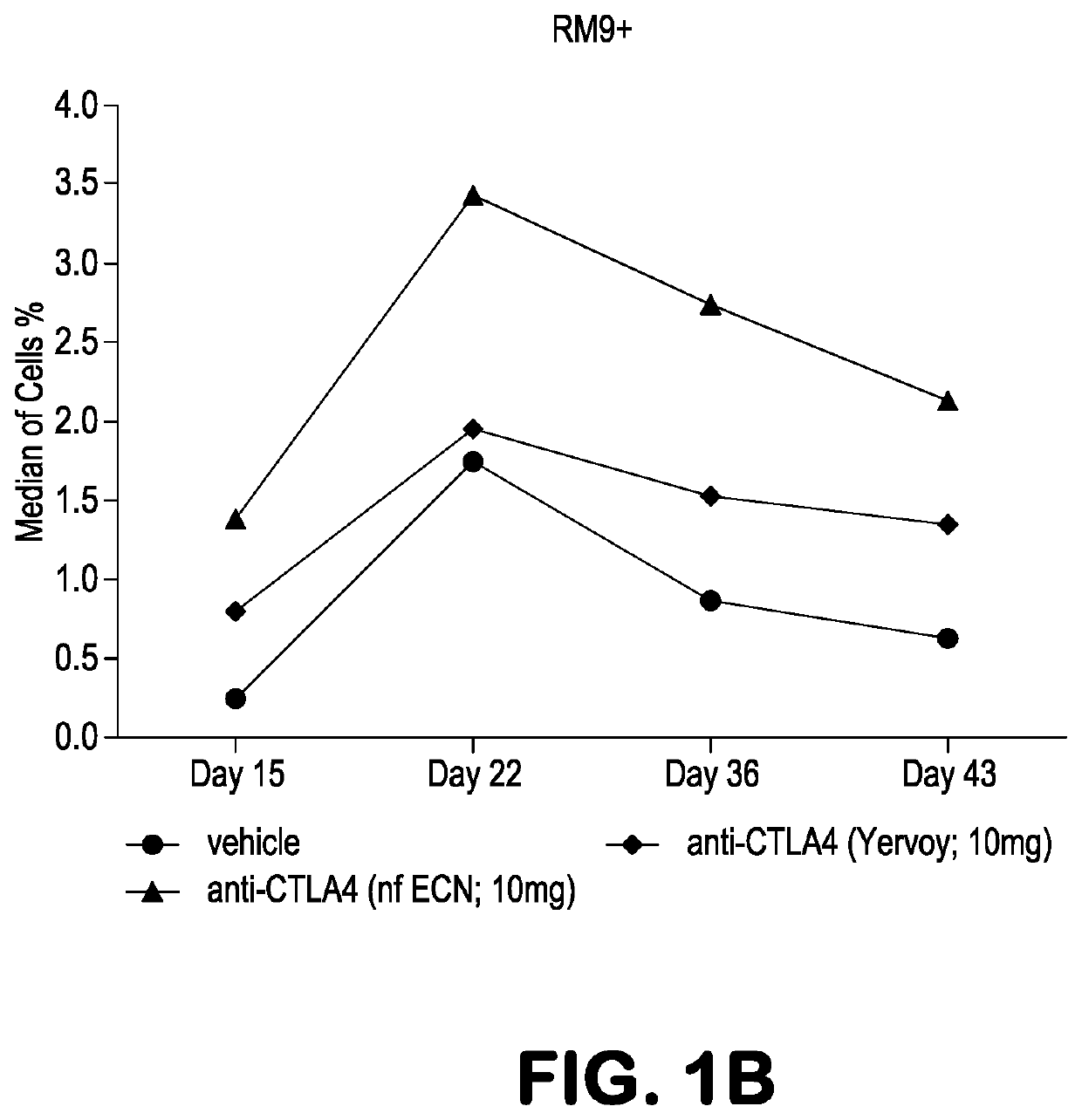Use of Anti-ctla-4 antibodies with enhanced adcc to enhance immune response to a vaccine
a technology of immunomodulatory antibodies and vaccine adjuvants, which is applied in the field of vaccine adjuvants enhancing immune responses, can solve the problems that existing adjuvants are not always completely effective, vaccines don't always elicit immune responses, etc., and achieve enhanced adcc activity, enhanced binding to activating fc receptors, and enhanced adcc
- Summary
- Abstract
- Description
- Claims
- Application Information
AI Technical Summary
Benefits of technology
Problems solved by technology
Method used
Image
Examples
example 1
Anti-CTLA-4 Vaccine Adjuvant Experiments in Cynomolgus Macaque
[0091]Experiments were performed in Mafa-A1*063+ Mauritian cynomolgus macaques (Macaca fascicularis; MCM) to track the effects of anti-CTLA-4 antibody variants differing in ADCC activity on the immune modulation of vaccine-induced antigen-specific T-cell responses over time. Three different anti-CTLA-4 monoclonal antibodies were studied: ipilimumab (ipi), nonfucosylated ipilimumab (ipi-NF), and ipilimumab having an N297A mutation (ipi-N297A), which completely blocks N-linked glycosylation. The nonfucosylated ipilimumab exhibits enhanced ADCC, whereas the N297A ipilimumab exhibits reduced / eliminated ADCC, compared with ipilimumab.
[0092]Viral vaccine immunogens were constructed by introducing the genes for simian immunodeficiency virus (SIV) Gag and Nef proteins into adenovirus serotype 5 (Ad5) vectors. The Nef gene sequence was modified to remove the second and third amino acid residues (Gly-Gly) to remove a myristolation ...
example 2
Anti-CTLA-4 Antibody with Enhanced ADCC Measured by Promotion of NK-Mediated Cell Lysis Using Primary Human Cells
[0100]Nonfucosylated ipilimumab was tested for its ability to promote NK cell-mediated lysis of Tregs from a human donor as follows. Briefly, Tregs for use as target cells were separated by negative selection using magnetic beads and activated for 72 hours. NK cells for use as effectors from a human donor were separated by negative selection using magnetic beads and activated with IL-2 for 24 hrs. Calcein-labeled activated Tregs (Donor Leukopak AC8196) were coated with various concentrations of ipilimumab, ipilimumab-NF or an IgG1 control for 30 minutes, and then incubated with NK effector cells at a ratio of 10:1 for 2 hours. Calcein release was measured by reading the fluorescence intensity of the media using an Envision plate reader (Perkin Elmer), and the percentage of antibody-dependent cell lysis was calculated based on mean fluorescence intensity (MFI) with the fol...
example 3
Assay to Determine Percentage Nonfucosylated in a Sample of Anti-CTLA-4 Antibodies
[0101]Nonfucosylated anti-CTLA-4 mAb preparations are analyzed to determine the percentage of nonfucosylated heavy chains essentially as follows.
[0102]Antibodies are first denatured using urea and then reduced using DTT (dithiothreitol). Samples are then digested overnight at 37° C. with PNGase F to remove N-linked glycans. Released glycans are collected, filtered, dried, and derivatization with 2-aminobenzoic acid (2-AA) or 2-aminobenzamide (2-AB). The resulting labeled glycans are then resolved on a HILIC column and the eluted fractions are quantified by fluorescence and dried. The fractions are then treated with exoglycosidases, such as α(1-2,3,4,6) fucosidase (BKF), which releases core α(1,6)-linked fucose residues. Untreated samples and BKF-treated samples are then analyzed by liquid chromatography. Glycans comprising α(1,6)-linked fucose residues exhibit altered elution after BKF treatment, where...
PUM
| Property | Measurement | Unit |
|---|---|---|
| heat-inactivated | aaaaa | aaaaa |
| frequency | aaaaa | aaaaa |
| chemical identity | aaaaa | aaaaa |
Abstract
Description
Claims
Application Information
 Login to View More
Login to View More - R&D
- Intellectual Property
- Life Sciences
- Materials
- Tech Scout
- Unparalleled Data Quality
- Higher Quality Content
- 60% Fewer Hallucinations
Browse by: Latest US Patents, China's latest patents, Technical Efficacy Thesaurus, Application Domain, Technology Topic, Popular Technical Reports.
© 2025 PatSnap. All rights reserved.Legal|Privacy policy|Modern Slavery Act Transparency Statement|Sitemap|About US| Contact US: help@patsnap.com



